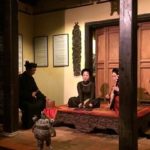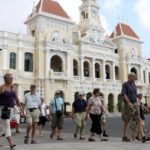The exhibition titled “Stroll through the Lacquer Land” will be held in Hanoi, showcasing nearly 30 works by 10 renowned lacquer artists. This unique exhibition, featuring a variety of artistic perspectives, will take place from August 2 to 8 at the Vietnam Fine Arts Museum, located at 66 Nguyen Thai Hoc, Hanoi.
One of the highlighted artists in the exhibition is Painter Phan Cam Thuong, who described his lacquer technique as reminiscent of the ancient Buddha statues. According to him, the drying process of ancient lacquer may be time-consuming, but it results in a transparent and water-like effect. He emphasized that lacquer is not just a material, but a way of drawing, and the material itself holds little significance in the creation of artworks.
Another notable artist featured in the exhibition is Painter Ly Truc Son, who discovered his talent for painting at a young age of 12. Known as the leading painter of contemporary lacquer art, Son founded the “Son Ta” (Wax Tree) group and is admired by colleagues worldwide. He spoke about his meticulous approach to each painting, drawing with discipline, respect, and care to achieve the desired artistic effect. Son humbly acknowledged that he continues to strive for improvement in his work.
Painter Trieu Khac Tien stands out as the only Vietnamese lacquer artist with a Ph.D., which he earned from the Tokyo University of Fine Arts, Japan. Tien expressed his desire to standardize the painting techniques of Vietnamese lacquer art to increase its durability and value. He drew inspiration from Japanese lacquer art and its historical preservation and development.
The curator of the exhibition, Van Vi, described lacquer painting as a miraculous form of Vietnamese fine art. She viewed comprehending the field of lacquer painting as akin to taking a gentle walk, allowing time to appreciate and grasp the diverse approaches and evolution of lacquer art.
Vietnamese lacquer painting has a long history, but it was not until the establishment of L’Ecole des Beaux-Arts de l’Indochine (the Indochina College of Fine Arts, now known as the Vietnam University of Fine Arts) in 1925 that artists began to transform lacquer from a mere craft into an artistic invention. Initially, Indochinese artists attempted to paint lacquer using oil painting techniques taught by French professors, but they soon realized the need for a distinct approach to this new material.
Among the pioneer generation, one of the well-known figures was Nguyen Gia Tri, who followed an expressionist style. The second-generation lacquer painters, including Le Quoc Loc, Hoang Tich Tru, and Pham Hau, embraced a more decorative style that utilized the strengths of traditional Vietnamese art, influenced by the second director of the Indochina College of Fine Arts, Evarite Jonchère.
The concept of composing with lacquer paint was redefined by the third generation, particularly painters Nguyen Sang and Nguyen Tu Nghiem. Looking towards the future, Van Vi raised questions about the contributions and progression of the fourth generation in contemporary lacquer art. The exhibition aims to showcase paintings from various northern lacquer sects, leaving the mysteries and exploration of these questions to art scholars.
Curator Van Vi emphasized that each artist in the exhibition is on a unique artistic path to explore lacquer. Some artists embrace conventional techniques, while others pursue unorthodox approaches, creating a dialogue with materials and techniques. Viewers can expect to savor the fruits of their artistic labor, witnessing both amalgamation and distinction in the displayed artworks.
Ancient house in Ma May
NDO – Ma May, a rare quarter that still retains several old houses, has created one of the characteristics of Hanoi. Hanoi’s streets are becoming increasingly crowded and traditional features can sometimes be hidden behind modern life. But if one takes the time to relax and look around, the ancient features begin to reveal themselves.








